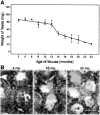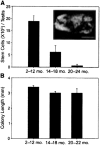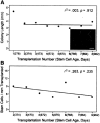Effects of aging and niche microenvironment on spermatogonial stem cell self-renewal
- PMID: 16456131
- PMCID: PMC5501308
- DOI: 10.1634/stemcells.2005-0580
Effects of aging and niche microenvironment on spermatogonial stem cell self-renewal
Abstract
Aging is evident in most tissues and organ systems, but the mechanisms of aging are difficult to identify and poorly understood. Here, we test the hypothesis that aging results in uncorrected defects in stem cell and/or niche function, which lead to system failure. We used the spermatogonial stem cell (SSC) transplantation assay to determine the effect of aging on testis stem cell/niche function in mice. Between 12 and 24 months of age, male mice experienced a declining level of fertility associated with decreased testis weight, level of spermatogenesis, and total stem cell content. However, when stem cells were consecutively passaged at 3-month intervals to testes of young males, these stem cells continued to produce spermatogenesis for more than 3 years. Thus, SSC self-renewal continues long past the normal life span of the animal when the stem cell is continually maintained in a young niche/microenvironment. Moreover, these data suggest that infertility in old males results from deterioration of the SSC niche and failure to support an appropriate balance between stem cell self-renewal and differentiation.
Conflict of interest statement
Figures





References
-
- Schofield R. The relationship between the spleen colony-forming cell and the haemopoietic stem cell. Blood Cells. 1978;4:7–25. - PubMed
-
- Rao MS, Mattson MP. Stem cells and aging: Expanding the possibilities. Mech Ageing Dev. 2001;122:713–734. - PubMed
-
- Trosko JE. Human stem cells as targets for the aging and diseases of aging processes. Med Hypotheses. 2003;60:439–447. - PubMed
-
- Van Zant G, Liang Y. The role of stem cells in aging. Exp Hematol. 2003;31:659–672. - PubMed
-
- Harrison DE. Competitive repopulation: A new assay for long-term stem cell functional capacity. Blood. 1980;55:77–81. - PubMed
Publication types
MeSH terms
Substances
Grants and funding
LinkOut - more resources
Full Text Sources
Other Literature Sources
Medical
Miscellaneous

